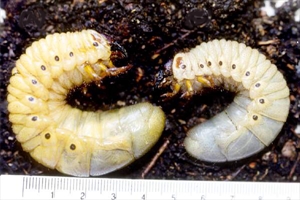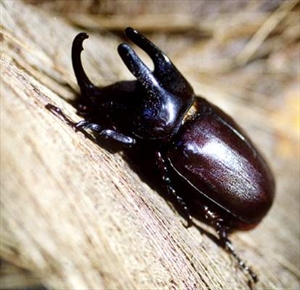- Widespread distribution. Southeast Asia, Papua New Guinea, Solomon Islands. On coconut, oil palm, betel nuts; also, banana, sugarcane, wild palms. Important on palms <5-years-old, in newly cleared forests; less when logs rot away.
- Eggs, large (5 x 3 mm) white, laid near rotting logs and other debris; larvae C-shaped up to 10 cm; adults black (4-6 mm long), horned; strong flyers.
- Cultural control: replant coconuts in old plantations; remove/destroy breeding sites, e.g., large logs; use ground legumes, e.g., Pueraria or Mucuna; use fast growing varieties, e.g., Gazelle Tall in Papua New Guinea.
- Chemical control: trap with pheromone (both sexes).
Pacific Pests, Pathogens and Weeds - Online edition
Pacific Pests, Pathogens, Weeds & Pesticides
Coconut rhinoceros beetle - Melanesian (057)
Melanesian rhinoceros beetle, coconut rhinoceros beetle, Scapanes
Scapanes australis. Different sub-species (Scapanes australis australis and Scapanes australis grossepunctatus) exist in Papua New Guinea; the situation in Solomon Islands has not been studied.
AUTHORS Helen Tsatsia & Grahame Jackson
Information from Waterhouse DF, Norris KR (1987) Scapanes australis (Boisduval). Biological Control Pacific Prospects. Inkata Press. Melbourne. Photo 1 Pita Tikai, SPC, Honiara, Solomon Islands. Photos 2&3 L. Beaudoin-Ollivier, CABI (2010) Scapanes australis (rhinoceros beetle) Crop Protection Compendium (https://www.cabi.org/cpc/datasheet/49241).
Produced with support from the Australian Centre for International Agricultural Research under project PC/2010/090: Strengthening integrated crop management research in the Pacific Islands in support of sustainable intensification of high-value crop production, implemented by the University of Queensland and the Secretariat of the Pacific Community.






